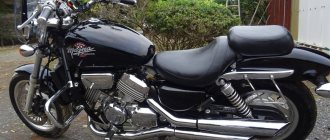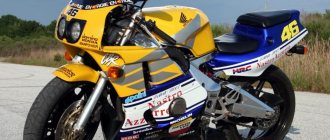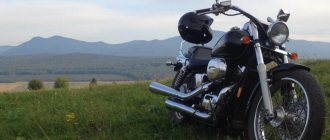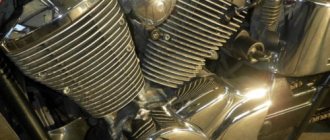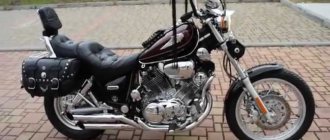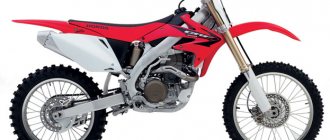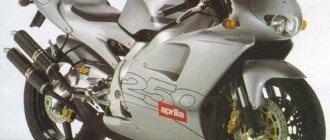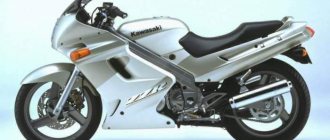Magna VF 750
- Honda motorcycle model
The Honda Magna 750 cruiser model appeared in 1982 as the “brother” of the Honda VF750S Saber model. The factory model designation is Honda VF750C. It became the first production cruiser with a V-shaped 4-cylinder engine from the Honda VFR750 sports tourer. The model was available in Japan, Europe and North America.
The first modifications of the Honda Magna 750 had the classic appearance of Japanese cruisers of that time - a short wheelbase, road fork offset, double disc brakes, cardan drive and hydraulic clutch.
Since 1987, the model has been seriously updated in appearance and receives the features of a power cruiser - a lower part, wide rear tires on a monolithic alloy wheel, expressive exhaust pipes, a stepped saddle and a front brake with a single disc. This generation has a maximum power of 77 hp. (Japanese versions), export modifications (North America, Great Britain) produced up to 88 hp.
Since 1993, the Magna model has undergone another major restyling. Getting a more modern appearance, it is also equipped with a chain drive (instead of a cardan), a cable clutch drive (instead of hydraulics), a new engine with a modified timing system, a 5-speed gearbox (previous versions - 5-speed + OD (overdrive), new wheels and carburetors with enlarged flaps.
2003 was the final year of production of the model, after which it left the assembly line and did not receive further development. However, throughout its production, the Magna 750 has won a huge army of fans around the world, who still prefer this particular model.
The “younger brother” of the model is the Honda Magna 250.
The model also has a name - Honda VF 750 Magna.
The main competitors of the Honda Magna 750 (V45) in the class:
Yamaha FZX 750
001_MOTO_0610_038
Honda VF750C Super Magna: cruiser, 1987–1989, 648 cm³, 70 hp, 90,000–180,000 rub.
Honda VF750C Super Magna: cruiser, 1987–1989, 648 cm³, 70 hp, 90,000–180,000 rub.
“Big”, “great”, “best”... And specifically in the feminine gender. If this Honda were a “man,” it would be a Magnum. It turns out that there is some kind of tautology in the name of the model: it seems that “magna” itself carries a superlative degree, and then there is also “super”. It turns out to be some kind of “super excellent” or “very great”. Let us not reproach the creators for excessive love of narcissism. The motorcycle really turned out excellent, both externally and internally.
1983. The history of the Magna family begins back in 1983, when the concern released two models: the “classic” Saber and the custom Magna. They are related by a 4-cylinder, 4-valve V-shaped power unit with a six-speed gearbox and cardan drive, built on the basis of the racing NR500, “inflated” to 750 cm3. Nowadays, every manufacturer has a “muscle custom” in its line—custom bikes with a sporty twist. Here is the HD V-Rod, and the Suzuki VZR1800Z, and the Honda VTX1800C... What about 20 years ago? To stick an engine (oh horror! - not a V-twin), and moreover, from a sportbike into a custom one - was considered crazy! In subsequent years, the motorcycle remained almost unchanged, except that versions with 1100 and 500 cc engines appeared.
1987. The revolution took place in 1987. Honda VF750C Super Magna became, perhaps, one of the first signs to notify the world that the Japanese have learned to make not only fast road cars, but also beautiful custom cars. If before almost all Japanese “choppers” were essentially more or less successful attempts to copy the style of the Great and Terrible HD, then the “super magna” is already a product of its own, independent and mature design school. The motorcycle created a sensation all over the world. A low, stretched silhouette, deliberately protruding covers of the airbox, which is not located at all in a classic place... and look at the brazenly raised exhaust pipes! The revolutionary design even now, after more than twenty years, does not look outdated. But just three years later, in 1989, the model was discontinued due to insufficient demand. Super Magna was well ahead of its time. But these days, motorcyclists have matured, and now clubs for Super Magna fans operate all over the world. Have you seen a club for fans of a twenty-year-old Japanese custom model? Time has caught up with the motorcycle that was born at the wrong time.
008_MOTO_0610_039
1993. In 1993, “at numerous requests from workers,” a completely new Magna appeared: “chain.” True, only the engine layout and name make it similar to the previous model. More traditional and quiet design, chain drive (hence the nickname), 5 gears - no more revolutions! Honda didn’t want to take risks, although apparently in vain. The army of Super Magna fans greeted the “chain” with an openly cold reception. Those who were waiting for the continuation of old traditions were left with their noses, and the latest “Magna” occupied a completely different niche, becoming more “just” a custom with an unusual engine.
DO NOT LOOK AT THE REGISTRATION. Super Magna was officially sold only in Japan and the United States. Unlike most “internal Japanese”, this model does not have electronics that limit the speed to 180 km/h, as well as engine “stranglers” in terms of power, so there is no fundamental difference between the modifications. Among the differences are the traditional US reflectors on the side surfaces of the fork and rear fender and the speedometer, marked in miles per hour. There is another version of the motorcycle - “California”. Due to the requirements of state environmental legislation, the motorcycle is equipped with a system for recirculating crankcase gases, gasoline vapors from the tank and other harmful “exhausts”. It can be identified by a plastic tank and a dozen additional rubber tubes entwined around the motorcycle. The system, as they say, “does not affect the speed,” so for Russia there is no fundamental difference in the presence or absence of this “mulka.”
“HALF A CUP” IS NOT EXTRA! There is also one little-known trick in “motor matters”: the first batches of Super Magna released for the United States market were equipped with engines with a displacement of 699 cm3. The reason for this was the high customs duties that 750 cc motorcycles were subject to. A year later, in '88, American customs tightened the screws even tighter, and now even 700 cc motorcycles fell into the same category as the 750. Since there were no longer any “customs” differences between the modifications, the basic 750 cc model began to be supplied to the American market. “Inner-Japanese” have always been only 750 cc. Therefore, if, when choosing a device, you come across an “American” made in 1987, pay attention to the displacement marking (it is cast on the side of the cylinder blocks).
Review of the Honda VF 750 Magna (V45) motorcycle
I opened category A and started the new season with a Magna V45, brought with a mileage of 5000 km from Japan. I took a chopper-shaped motorcycle with the expectation that it would not provoke dangerous maneuvers and because I love beautiful equipment... The engine is a V-shaped 4-cylinder, with a volume of 750 cubic meters, 77 horsepower (for America they were more powerful - 88 horses !). Basically, it's a dragster. A kind of lean chopper with an engine from the sport-tourist Vifer. The drive to the wheel is via a cardan. According to the manual, maintenance is done every 15 thousand, in practice I change it more often. Cooling is liquid. I use 95 gasoline. And it eats well; if you drive fast, it can consume 10 per hundred, especially after installing a jet kit in the carbs (and there are 4 of them), which increases the torque at the bottom. Now the rpm can be kept about 1000 less. (maximum revolutions - 10 thousand, pulls normally from 3 thousand, main operating speeds - 4.5-7 thousand revolutions) Tank - 13 liters. Yes, the gearbox is naturally manual, 6-speed. I had little experience driving a manual, so I had to get used to it. But on a motorcycle, mechanics are a blessing, because... it does not interfere due to the fact that the motorcycle is not stuck in traffic jams, but the absence of unexpected switches in a turn is very desirable.
By itself, my motorcycle is low and long, so it doesn’t rear up on its own (although a professional in his field will probably bully it), and if on cold tires I overdo it with gas or just suddenly release the clutch, it leaves black stripes and grinds the asphalt with the wheel.
Thanks to the motorcycle, I was able to go to work while living in the country. In the morning traffic jams, along the Minsk highway, I got to the very center in an average of an hour or an hour or 10... The same way back. And this is 90 km one way.
It’s just hard to describe how great it is to be transported from hot, stuffy Moscow to nature in an hour and have dinner at a table in the garden, listening to birds singing and throwing pine cones into the samovar... I just got there by car - I need to go straight to sleep... It’s long and hard.
Among the breakdowns, the carbs began to become clogged, either they put gasoline and sand in my tank, or the tank began to rust, but the needles sank and the carbs were flooded. As a result, after disassembling and cleaning the carbs, a gas filter was installed and the problem disappeared. There is a stupid story connected with this. On an empty road near Moscow, going from Kubinka to Zvenigorod, the needle in my carburetor apparently got stuck and the carbs were flooded. After suffering for some time this way and that, pouring gasoline from the carburetors, the engine was brought back to life, but the smoke was pouring out thick and white, like from an IZH. I jumped into the saddle and let him “shit” to the fullest. Everything unnecessary was burned out, the smoke disappeared and suddenly the motorcycle stalled... I stopped in complete disarray on the side of the road and began to think what to do, since I assumed that the carbs were to blame again... Luckily for me, guys were riding from the bike rally on choppers, who, like As is common among normal motorcyclists, they stopped and together with me began to look for a solution to the problem... When it turned out that I had simply run out of gas, I just felt like a complete idiot!! In general, everyone poured gasoline for me from their tanks and I was able to continue my journey. Guys, if you are reading this, THANK YOU again!
I bought my Magna completely by accident. Initially I wanted to take an old Golda, but her owner never deigned to bring her back to normal, and I made an advance payment back in February. In April, I accidentally saw a motorcycle in a service center in the same form - the frame was under the wall, the engine was lying nearby, all the accessories were on the shelves and corners. And then the season opened and we had to figure something out quickly. A friend of mine just brought motorcycles for sale and I went to look. Among the motorcycles that arrived to him was a black Magna vf750, produced in 2001 with 89 horses. The motorcycle looked quite attractive, it had new tires, all the consumables were changed (they were changed at my request), the chrome was corroded by rust in some places, but everything else was in order and worked. I decided to take it, until that moment I had only driven sports - before Magna I was running around on a 919 razor.
The first impressions made me very happy - the motorcycle handled very well. Handling is classic. The center of gravity is low, the front wheel is not very far forward, which makes the motorcycle nimble; in general, it is very comfortable to ride in the city. The bike copes with traffic jams no worse than sports. There are no brakes. After the reinforced hoses were installed, the situation improved a little. The advantage is that you can ride safely and not be afraid of the front wheel slipping. In choppers, when the front wheel falls off on a straight line, Magna stupidly continues to slide forward. In short, some kind of attraction. After sports, such things are very relaxing, you won’t get that high there. Here, even in a turn, breaking the front does not threaten you with a fall, the main thing is not to get too full.
As for the seating position, it is comfortable, the saddle is comfortable, but the pegs with a specific forward reach bothered me quite a lot. In principle, I don’t like the choppy position, it’s completely unnatural, plus it severely limits movement, which is not good when driving a motorcycle. It is not very convenient to change gears with your leg extended forward - sport or classic in this sense are much more convenient. It is generally impossible to stand up on the steps, and therefore, moving over potholes and bumps, even small ones, causes pain in the spine. Such a motorcycle is completely unsuitable for long-distance driving - it is purely urban transport.
The engine is a good 750 cc, exactly like the one on the old Vyfer. It starts a little sluggishly, I was really a little spoiled by the more powerful engine. Basically, this is an ideal engine for beginners. It drives the same in any gear, not capricious and reliable - what more do you need?
Having driven the bike into my garage, I cleaned all the rust from the chrome, changed the oil in the fork - I filled it with a harder one, replaced the handles on the steering wheel - I installed ones that were comfortable for me. I also wanted to screw on the back and glass, but a friend really liked the bike, so before I had time to do this, he took it for himself and drove it for three seasons, of course.
Now, I almost forgot, there’s almost no light, there’s a tiny headlight, so why the hell change this kind of equipment for something more sensible. Okay, no problem with that now. The fuel gauge is also missing - instead there is a small light bulb. The tank is small, but this compensates for the moderate fuel consumption.
In general, the motorcycle is very beautiful, there is some kind of zest in it, or something. Good for beginners, even suitable for a girl, due to its low seating and ease of control.
I've been riding a Magna for the 3rd season. Well, what can I say... In terms of dynamics and power, it easily tears up any chopper-liter (and even more!) Provokes unscrewing. Good weight - not big and not small. Steering is not bad. (relative to other chopper-like ones) The seating position is quite comfortable -closer to the classic. (you can stand up on the steps on the pits) These are advantages. Of the disadvantages: a child’s tank (boils) and not a child’s appetite (if you fry it). Chain (universal shaft, of course, less gimmorous) The layout is dense (4 kule boilers...) Brakes (or rather the lack thereof) But... For me, Magna is like a beloved woman! You know all the shortcomings, but you forget about them in bed (on the road) where she is a HURRICANE!!! In general, I love her!!!
I'm not going to change this pepelats yet. Last season I installed roll bars, 70-liter panniers and a windshield. For this season, I boiled the tank down to 22 liters and installed a reinforced hose on the front brake. Happy as an elephant))). Now we need to come up with something with the rear shock absorbers, because... They have a very short stroke and sometimes leak when fully loaded. In general, only positive impressions. A very reliable device that can be used as a cruiser. I really like the handling, it handles almost like a classic! No breakdowns were noted.
002_MOTO_0610_038
Honda VF750C Super Magna
Honda VF750C Super Magna
POWER UNIT. The famous Honda V4 framed by Super Magna is an extremely reliable, well-developed and polished unit, free from “childhood diseases”. Even today, after more than 20 years and hundreds of thousands of kilometers, the engines work like clockwork. A peculiarity of the engine is the rather loud knocking of valves on a cold engine, which disappears only after warming up to operating temperature (7-10 minutes at idle). If the knocking does not go away, it means that the thermal clearances of the valves have “floated away” and adjustment is required. This procedure is quite labor-intensive - the layout of the motorcycle is very tight, and you will have to unscrew a lot of things, but the adjustment mechanism (screw - nut) is simple and does not require fussing with measurements and searching for adjusting washers. It is recommended to “feed” a highly accelerated, high-revving engine with sportbike roots with synthetic grades of oils for sports motorcycles. Arguments like “why does an old motorcycle need hi-tech” are completely unacceptable in this case. With cheap oil, the engine will last much less than expected. If you had to disassemble the engine for repairs, you should pay very close attention to the markings of similar parts (camshafts, rockers, etc.). It’s easy to confuse some parts during assembly, and even a Honda engineer cannot determine “by eye” which shaft comes from which head. Incorrect engine assembly will only lead to a scrap metal collection point.
REAR CYLINDER HEADS. The only technological “jamb” of the engine is the insufficient supply of oil to the rear cylinder heads.
The reason for this is the poor design of the lubrication system. Oil enters the rear head of the block through the gearbox, where there are already plenty of lubricant consumers. In especially severe cases (especially when the crankcase contains budget semi-synthetics or, worse, mineral water, as well as a low oil level), serious scuffing of the camshaft journals, their beds, cams and rockers occurs. To get rid of this problem once and for all, you can lay a new oil line directly from the oil pump to the head, bypassing the gearbox. Such tuning requires some experience, but in general there is nothing complicated about it. A reinforced brake hose can be used as an oil line.
007_MOTO_0610_039
The sporty nature of the motorcycle is emphasized by the instrumentation in sportbike colors: the tachometer is dominant, the speedometer is secondary.
The sporty nature of the motorcycle is emphasized by the instrumentation in sportbike colors: the tachometer is dominant, the speedometer is secondary.
CHASSIS. The motorcycle frame is designed extremely well for its time. Perhaps the Super Magna is one of the few custom cars of its time with no particular complaints about the frame rigidity. Due to the long wheelbase, low center of gravity and significant fork angle, the motorcycle has excellent directional stability, which is why it is very popular among truck drivers, but with active maneuvering things are worse. The front fork with a tube diameter of only 39 mm and rather soft settings does not stand up to criticism. When cornering, it “twists” noticeably, which is facilitated by a significant angle of inclination. The situation is saved a little by installing a third yoke above the wing and filling with oil with a viscosity of 15W or even 20W. But you still shouldn’t expect sporty habits from an old custom car.
SO THAT THE STORE DOESN'T BEND. A serious problem is the rear shock absorbers. The youngest of the existing Super Magna is already 21 years old, and the non-separable shock absorbers for the most part have long since run out, especially if the motorcycle has had time to ride around Russia. The original units have long been discontinued, but you can still order them from the thrifty Japanese (albeit for crazy money). Used racks are a little cheaper at online auctions, but, of course, without any guarantee. There is a cheaper way out of this situation: tuning companies (for example, YSS) have not ignored our hero, so you can order quite budget aftermarket racks.
Modifications
No official modifications were made based on the motorcycle. But if you remember the third generation, which completely changed the chassis, it can be considered a variation.
Over the many years of production, the motorcycle changed colors several times.
and competitors
Despite the fact that the Honda model has long been considered a standard cruiser, competitors failed .
Only Yamaha . Its road bike FZX 750 , born in 1986, nicknamed outside Japan “the first Fazer” (the legendary liter would be born only 15 years later), could in many ways compete with Honda’s cruiser, but could not become a full-fledged replacement.
003_MOTO_0610_039
The rear drum brake shows the age of the model.
And even though the pads last for many tens of thousands of km, their effectiveness is “nothing.” The rear drum brake shows the age of the model. And even though the pads last for many tens of thousands of km, their effectiveness is “nothing.”
BRAKES. Perhaps the most striking “imprint of the past” is the braking system. The only disc with a two-piston floating caliper at the front does not correspond to the dynamic capabilities of the motorcycle and is clearly weak in the conditions of the modern rhythm of movement, and the rear “drum” with a mechanical drive is nothing more than a “dead weight” - there is practically no sense in it. You have to put up with this feature of the model - this is the problem with almost all old motorcycles. The only thing you should definitely do is install a reinforced hose. Most likely, no one has changed the “original” line, and Honda recommends replacing all brake hoses at least once every 6 years. And the feedback on the lever will noticeably improve.
004_MOTO_0610_039
The welded steering wheel is an unusual design.
When dropped, it does not bend as usual, but cracks along the welding seams. The welded steering wheel is an unusual design. When dropped, it does not bend as usual, but cracks along the welding seams.
STEERING WHEEL. The steering tube has an unusual welded structure, assembled from five separate elements. When choosing a motorcycle, you should carefully examine this unit. Even minor falls can cause welding to crack. There is no need to explain how dangerous it is to drive with such a defect.
VOLTAGE REGULATOR RELAY. A typical problem with old Hondas. It always fails completely unexpectedly. There can be only two reasons for this: either the battery has “decided to live for a long time”, or simply “the time has come.” In any case, before purchasing, it is better to check the functionality of the device. The voltage in the on-board network of a running motorcycle must be at least 13.5 V.
Specifications
It is the filling of the Honda Magna 750 V45 that is the main achievement of the Japanese company; all owners of the motorcycle note excellent traction, high power and Japanese branded quality. Despite such high engine power, it did not emit much vibration and showed excellent traction at low speeds. The drive to the rear wheel was working, a cardan shaft was installed. Fuel was supplied to the engine using 4 carburetors, because it had to be fully consistent with such power.
The designers were also able to ensure that the piston stroke became small, which increased the number of revolutions and power. Disc brakes were responsible for maximum safety when driving; there were 2 discs in front. The suspension will surprise few people, but its reliability and performance have proven to be the best. There is a standard telescopic fork at the front and a double shock absorber at the rear. The last of the presented generations was produced with shock absorber preload adjustment.
006_MOTO_0610_039
The “K&N” low resistance filter is an excellent alternative to the “original”, which you won’t find during the day.
The “K&N” low resistance filter is an excellent alternative to the “original”, which you won’t find during the day.
AIR FILTER. Due to the “antiquity” and low prevalence of the model in Europe, it is very difficult to find an original air filter in stock, and of the alternative manufacturers, only K&N offers its analogue, and then, according to its tradition, it is not paper, but reusable, with low resistance. So the owner is left with two options: either prudently order a new air filter a month and a half before the next maintenance, or install a serviced K&N.
005_MOTO_0610_039
The release is the pride and beauty of Supermagna.
But the protective pads are often lost. The release is the pride and beauty of Supermagna. But the protective pads are often lost.
EXHAUST SYSTEM. This is the pride and fetish of every magnet driver. Indeed, these “ends” are still firmly in the top ten of the world beauty contest of exhaust systems. But there are problems here too. Sometimes the lower pipe bends located under the engine burn out. Depending on the general condition of the assembly, you can either weld it with a sheet of steel, or, if things are really bad, look for a replacement - of course, a used one. Of course, you can “prank” tuning pipes, but this is akin to installing wheels from a Gazelle on a Rolls-Royce. The second “headache” for magnetic guides is the chrome-plated sliders at the ends of the pipes. In theory, they are designed to protect pipes during falls, sacrificing themselves, but often these linings simply fly away, becoming loose from vibrations. These decorative elements, of course, do not affect the driving performance, but the appearance of the “main pride” of the motorcycle suffers significantly, so when buying a device you can safely bargain for a round sum (see the spare parts table).
ESTIMATED COST OF SPARE PARTS HONDA VF750C Super Magna
Name | Original spare parts, rub. | Non-original spare parts, rub. |
| Oil filter | 620 | 370 (Hiflo) |
| Air filter | 1300 | 2000 (K&N) |
| Spark plugs (set) | 650 (NGK-Honda) | 500 (NGK) |
| Brake pads (set for two wheels) | 3100 | 2200 (Vesrah) |
| Muffler cover (1 piece) | 750 | — |
| Relay regulator | 11 200 | 3000 |
| Rear shock absorbers (set) | 28 000 | from 7000 (YSS) |
Spare parts, mostly available in stock.
Spare parts are sometimes in stock. Spare parts, mainly imported to order. We thank Yuri Borzunov for his help in preparing the material and the motorcycles provided for filming. Honda VF750C Super Magna
Brief history of the model
1982 - start of production and sales of the model. First generation. Model: Honda VF750 Magna (Europe, North America, Japan). Factory designation: VF750CC.
1983 - no significant changes. Model: Honda VF750 Magna (Europe, North America, Japan). Factory designation: VF750C.
1984 - no significant changes. Model: Honda VF750 Magna (Europe, North America, Japan). Factory designation: VF750CE.
1985 - no significant changes. Model: Honda VF750 Magna (Europe, North America, Japan). Factory designation: VF750CF.
1986 - no significant changes. Model: Honda VF750 Magna (Europe, North America, Japan). Factory designation: VF750CG.
1987 - restyling of the model. Second generation. The model gets a new appearance, a single-disc front brake, a new front fork without anti-dive, a new wheel size, a 13-liter fuel tank, and increased maximum power (77 hp for Japanese versions). Model: Honda VF750 Magna (Europe, North America, Japan). Factory designation: VF750CH.
1988 - no significant changes. Model: Honda VF750 Magna (Europe, North America, Japan). Factory designation: VF750CJ.
1989-1992 - the model is not produced. 1993 - restyling of the model. Third generation. The model gets a new appearance, a new wheel size, a cable clutch (instead of a hydraulic one), a chain drive (instead of a cardan drive), a new cartridge telescopic fork, new carburetors and a new engine (the timing system has been changed, the compression ratio has been increased to 10.5). Maximum power is 75 hp. (Japanese versions). The gearbox becomes a 5-speed with new gear ratios. Model: Honda VF750 Magna (Europe, North America, Japan). Factory designation: VF750CP.
1994 - no significant changes. Model: Honda VF750 Magna (Europe, North America, Japan). Factory designation: VF750CR.
1995 - no significant changes. Model: Honda VF750 Magna (Europe, North America, Japan). Factory designation: VF750CS.
1996 - no significant changes. Model: Honda VF750 Magna (Europe, North America, Japan). Factory designation: VF750CT.
1997 - no significant changes. Model: Honda VF750 Magna (Europe, North America, Japan). Factory designation: VF750CV.
1998 - no significant changes. Model: Honda VF750 Magna (Europe, North America, Japan). Factory designation: VF750CW.
1999 - no significant changes. Model: Honda VF750 Magna (Europe, North America, Japan). Factory designation: VF750CX.
2000 - no significant changes. Model: Honda VF750 Magna (Europe, North America, Japan). Factory designation: VF750CY.
2001 - no significant changes. Model: Honda VF750 Magna (Europe, North America, Japan). Factory designation: VF750C1.
2002 - no significant changes. Model: Honda VF750 Magna (Europe, North America, Japan). Factory designation: VF750C2.
2003 is the last year of production. Model: Honda VF750 Magna (Europe, North America, Japan). Factory designation: VF750C3.
